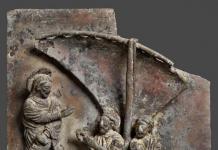To create non-standard interior or zoning a room there are many ways. Combining wallpaper is one of them, the least expensive in terms of resources and time. This technique is used by those who want to save money and neutralize existing design flaws: unprofitable ledges or niches, too low ceilings, narrow space. The main thing when renovating is to take into account all the features of the room.
The purpose of combining should be not just to relieve boredom. It is designed to focus attention on a certain point or zone. Aimless application of patches to the walls will make the interior look tacky and will only emphasize the owner’s lack of taste.
When accentuating one of the walls with wallpaper, you need to choose the “right” one. This is usually the wall that catches the eye when entering a room. It can also be located in the background part of one of the functional areas or behind a furniture group: dining table, desk, upholstered furniture, which will only benefit from a suitable background.
The principle of choosing a wall was absolutely unmistakable in Soviet times. The main attraction - the Uzbek carpet - always hung where it was needed and was visible from any vantage point.
The boundaries of the accent wall are also determined in advance. And this must be the entire wall, and not some part of it behind the sofa (what will happen if the sofa suddenly has to be moved?). These are not several walls, sometimes decorated with companions, but giving the impression that the room was papered with remnants from a previous renovation.
The following simple rules must be taken into account:
- Accent wallpaper is glued to the view wall. The desired minimum distance to it is 3-4 m. The “Khrushchev” kitchen, for example, is not very suitable for such a design.
- Combining two types of wallpaper with an active pattern is contraindicated, even if they are companions.
- Photo wallpaper or any other with a dynamic print in the best possible way combined with plain ones.
- To avoid having to rack your brains over the design of joints, accent wallpaper takes up space from one corner to another or to a niche or ledge.
- The basis for creating any combination should be a certain idea; it is necessary to rivet the eyes of those present on something specific.
Combination errors
All the mistakes of designers can be reduced to the following basic ones:
- Lack of purpose when combining, acting on a whim.
- Choosing the “wrong” wall.
- Placing wallpaper in pieces, with borders not in the corners. An exception is inserts with finishing of joints with moldings or when the wall is divided into two parts horizontally.
- The layout of the duet without taking into account the characteristics of the room.
In order not to spoil the picture of the fresh renovation, you cannot
- Place large furniture near a wall with large patterns; the optimal background in this case is plain;
- decorate a small room with dark colors; light shades are more harmonious, preferably no more than three;
- decorate a large wall in a narrow room with patterns, they will narrow the space even more;
- stick wallpaper with horizontal stripes at low ceilings, the ceiling will press even more;
- vertical stripes will make a narrow room with high ceilings even more awkward.
How to combine wallpaper by color?
Scientists have proven that colors affect not only mood, but also health. For a comfortable life, design colors are chosen for a reason. They are combined according to certain rules. Not all shades look harmonious next to each other. Sometimes even unexpected combinations fascinate, in other cases you want to look away quickly. Combinations for the interior are selected according to the same principle by which a bouquet or toiletries are collected.
Taking into account furniture and decor, there are usually three to four to seven colors in the room. There are never many of them, they only serve for variety and add emphasis. The main two are the colors of wallpaper, flooring, and furniture elements. When choosing a color, first of all pay attention to the size of the room.
The color scheme of the walls determines the overall decor of the entire room. Some color elements from a wallpaper pair are necessarily duplicated in the interior: repeated in furniture upholstery, echo the doors or floor and ceiling coverings.
Shades of the same color
The combination of wallpaper of the same color in one room is considered classic. The walls can be patterned, regular, chaotic, barely expressed. For small room two types of wallpaper with the same pattern, slightly different in shade - the combination is the most acceptable.
Monochromatic combinations can differ only in saturation. The priority zone is highlighted with richer shades.
Any room will look organic if it combines decorations of the same color, but with different textures. Textured elements look much more impressive if they are made in the same color. Shiny surfaces look unusual when combined with matte ones. Besides, small rooms, where there are shiny walls, will visually seem more spacious.
Contrasting colors
Correctly combining several bright paintings that you like in the interior is a delicate matter. Those without experience in this matter are on a slippery slope. It is also worth considering the price of assorted coatings. The look of expensive silk-screen printing can quickly be ruined by placing budget paper nearby.
The contrast method is most often used to decorate living rooms or bedrooms. One of the colors should be active, and the second neutral.
Modern design ideas based on style, rejection of everyday life. Special techniques consist of combining warm and cold colors and using catchy colors. Possible options are:
- simple, when harmonious, unidirectional color schemes are combined;
- moderate, when the wallpaper tones do not combine with each other, but have something in common with the space;
- complex if the interior is decorated with more than three colors of different saturations.
Adjacent shades of the color wheel
To maintain the integrity of the interior, and not to miss the choice of finishing colors, use a special cheat sheet called the color wheel. With its help, you can select similar colors by simply taking 2-3 or 5 located nearby.
Advanced designers usually use not 2, but 3-4 shades, which are diluted with universal black, white or gray. Since they do not exist in nature, they are not shown in the diagram. In the design of the premises they act not only as additional, but also as main ones.
Color combination (table)
Make your own choices suitable colors Interesting. But those without experience tend to make mistakes. There are tables that greatly simplify the process. The main thing is to know how to use them.
This or a similar scheme is used, remembering that the first color must be used as the main one. The two following it can act as additional ones, those that follow are accent ones.
There are tables that present contrasting combinations or those compiled on a complementary principle. From the proposed options, you just need to choose the combination that you like most.
How to design a transition when combining
Whether or not to decorate the joints when gluing depends on the thickness of the finish and the chosen style. There are several methods for decorating the transition: pasting borders with borders, moldings, wooden slats, thin strips, stucco molding, and ceiling plinths can be used.
No transition
The classic joint is usually not decorated with anything. To ensure that the edges of assorted wallpapers match perfectly, they are not initially coated with glue, but are placed overlapping each other. Then a sharp knife is drawn along the joint (the line can be smooth or wavy). The waste is discarded, and the edges of the canvases are coated with glue and attached to the wall.
Wallpaper border
Paper framing is not a problem. It can be matched to the wallpaper at the point of purchase from a catalog or cut out from the wallpaper strip itself. The advantage of this finish is its low cost, ease of gluing and removal. Disadvantage: susceptibility to ultraviolet radiation and mechanical damage.
You can choose vinyl and acrylic edging; they are approximately similar in quality. Textile is denser and more durable due to its two-layer structure consisting of paper and fabric.
You should not rely on the quality of the self-adhesive edging; it tends to fall off spontaneously over time. It is advisable to glue it, additionally coating it with glue initially.
Moldings
Looks quite original decorative elements framed with moldings. Such inserts were mostly used in classic interiors. Previously, such ideas were implemented only by representatives of the upper class, since the fabrics used were very expensive. Now such panels are possible in the style of Provence and country. Modern Art Nouveau follows the same path, slightly modifying the frame. Its role is played by a border cut from linen from the same collection.
Silk-screen printing, embossed coatings, and other similar options are used as inserts. Moldings will also help if you need to combine wallpaper different thicknesses, formalize the transition to another type of decoration, architectural element.
Combination methods
Combination is always creative, creativity. Some of his techniques are very bold, especially if the stylistic decision involves the use of bright contrasts and unconventional combinations. Therefore, you need to select the decor carefully. When purchasing materials, you need to consider the following key factors:
- degree of illumination;
- footage of the room;
- planned style;
- shades and textures should not “quarrel” with each other.
Choosing a texture is usually easier than choosing the right one color range. If all types of finishing in the apartment can be combined into one harmonious whole, a satisfactory result is obtained:
- the room seems to increase in size;
- irregular shapes, uneven walls are hidden;
- the interior is filled with light;
- separate zones appear;
- the winning features of the layout and style are emphasized.
Combining horizontally
The method is most successful if you wallpaper the room different types, for example, top part paper, and the bottom - embossed vinyl or non-woven. The walls will receive additional protection, and partial repairs will be easier and cheaper.
Horizontal stripes can be distributed over the entire height, alternating in color and pattern. If you decide to glue only two types of wallpaper, then the parts should be in a 2:1 ratio.
The height of the separation can be changed, focusing on the levels of furniture, window sill, taking into account the layout and size of the room.
Joints oriented horizontally are much more difficult to mask, so the use of moldings, all kinds of borders, and baguettes is appropriate here. Traditionally, the border is made at a height of no more than a meter, but only if the height of the walls is small. When non-standard high ceilings the joint is located at a height of 1.5-2 m. This distance is oriented relative to the floor, not the ceiling, otherwise the slightest unevenness will be noticeable.
Combining vertically
The essence of the method is to vertically connect wallpaper of different tones and textures. The method allows you to visually raise the ceiling level. The room will seem higher, the thinner the fragments of the picture. The stripes are not necessarily of the same size. Strips of different widths alternate in a certain sequence.
If the combined fragments are not the same in texture, moldings or borders will be required to decorate the borders.
Combinations of coatings of the same color, but of different intensities, alternation of dynamic shades with calm ones, wallpaper with patterns and plain-colored ones are popular. Flowers with stripes look good in a retro style.
Plain and plain
A technique ideal for highlighting several functional areas of space in a similar color scheme. Companions from the same manufacturer will be a win-win option. Not too variegated shades, relief patterns, and silk-screen printing look noble.
For a harmonious design, when using plain wallpaper, choose canvases with neutral and more active colors, and materials of different textures. The trick of having a brighter wall will draw attention away from the unevenness on a wall with a neutral color. In the bedroom, for example, deeper, darker shades are used in the sleeping area. The play of shadows helps to calm down and relax.
Accent wall
To ensure that the accent on the wall not only attracts the eye, but also improves the design, you must follow some rules:
- ideally there is only one such wall, rarely two, never three, this introduces dissonance;
- Only part of the wall or such can become accent architectural elements like arches, niches;
- accent colors are not necessarily bright, soft combinations are acceptable;
- You can “move” the accent wall using warm and cool shades.
It is necessary to remember: the technique dictates the mood of the entire interior, and therefore can either completely ruin it or balance it.
IN modern interior an accent wall usually sets the focal point. It is decorated with bright monochromatic canvases or wallpaper with large ornaments and digital printing. The color scheme of the remaining surfaces is as neutral as possible. This approach is applicable to any room. And due to the fact that expensive materials are used only on one of the walls, significant savings are achieved.
Pattern or ornament and plain
Collections often represent a popular combination option - plain wallpaper with the same ones, where a pattern or ornament is applied to the base.
If the selection of companions is carried out independently, you must be extremely careful, try to match future companions with good lighting. It is also important not to deviate from the rule:
- large drawings and bright colors are good only in a spacious, bright room;
- in a pair where the first part is an ornament, the second should be textural.
Pattern and Pattern
Different patterns look quite harmonious in one room. But they must have something unifying: motifs, some elements, color.
The technique is often used in horizontal combinations, when the lower part of the wall, for example, is decorated with wallpaper with an ornament, and the upper, lighter part is decorated with small flowers. In the same way, you can combine large monograms or a floral pattern with discreet geometric ripples that give the impression of a monochromatic background.
Two types of wallpaper are used for zoning, but only if they are not competitors. Colored companions divide, for example, a children's room, or allocate an area near the desktop. The connection point should not be provocative; it should not be decorated with moldings; it is even better if it is angular.
Patchwork technique
The combination is carried out using flaps, for which canvases are selected that are in harmony with each other. They are cut into identical or different pieces, glued end-to-end or overlapping, and placed like on a chessboard. The patches can be two-color or have more shades, with different geometric shapes: square, rectangular. They are cut out in the shape of a circle to make appliqués on finished walls.
A similar panel looks stylish at the head of the bed, in the nursery. If the color scheme seems too variegated, it is balanced with several white fragments.
Allocation of niches
When trying to disguise niches that seem to be a lack of a room, they often achieve the opposite effect. It's better to go the other way and highlight them. To do this, wallpaper is glued there in a different color or a couple of tones darker than the main ones. If you apply textured wallpaper, equip the niche with lighting; it will create an interesting interior relief and enliven the room with the play of shadows.
Using cold tones will allow you to visually distance the wall and shift the emphasis to the item located in the niche.
Room zoning
Sometimes one room is divided into zones, each of which performs its own function. Along with other methods, a method is used when part of the space is separated from the rest using wallpaper with patterns or other color shades.
The solutions are quite unusual. Separation is achieved not only by color, but also by texture. One option is to separate, for example, the kitchen from the dining room by wallpapering it structural wallpaper for painting. One area is decorated with a floral pattern, and the next one is decorated with a checkered print of the same color scheme. The main thing will be not to make a mistake with the arrangement of furniture.
Zoning with wallpaper will help you define the boundaries of the zone without effort and unnecessary expenses: neither plasterboard partitions nor heavy curtains are required.
Brick or stone masonry in the loft style is becoming less and less popular. Such a change in the interior requires a considerable investment of time and resources, and is not always acceptable due to the excessive load on the foundation. In conditions especially small apartment it is appropriate to replace this material with its imitation.
A room papered light wallpaper, complemented by a wall made of white brick. Red brick will look great when surrounded by matte gray or white walls. An apron in the kitchen work area and a fake fireplace in the living room will not be discordant if you correctly match the color scheme of your companions. The texture of the brick is conveyed so realistically that it can only be distinguished from the real thing by touching it.
Photo wallpaper, like any cladding with an active pattern, can only be combined with plain walls. It doesn’t matter what story the eye initially falls on. The main thing is to adhere to the basic rules:
- choose the right drawing;
- guess the size;
- maintain consistency in quality and palette between photo wallpaper and basic wallpaper.
There is no need to combine types of megalopolises by color. They will go with almost everything, as long as they are not variegated or even monochromatic. It is better to place lush greenery in rooms full of light. A white, beige or grayish main background harmonizes well with it.
Rooms with windows facing north are decorated with bright, large images. Sunflowers or oranges will warm you up and add sunshine. The remaining walls are covered with light, warm, dim wallpaper.
Photo wallpaper is also used for zoning, to emphasize the horizontal, to highlight architectural protrusions and niches. They are not so often combined with contrasting, rich companions: beige is combined with purple, green, blue and orange. Perspective images will significantly affect the size of the room.
To emphasize the interesting texture of the coating, the room is decorated in a single color. The use of flashy textures must be balanced with calm shades and the absence of unnecessary details and patterns. It is customary to combine a clear texture with the same companions or at least similar in thickness. It is better not to place the seams between them on a flat wall, but to place them in a corner.
Textured wallpaper is the best alternative to liquid wallpaper. The texture can appear in the form of stripes and curls, abstract images, and vegetation. The coverings are easy to glue, can be painted, are joined on walls, and used to decorate ceilings.
At first glance, liquid wallpaper looks like decorative plaster, is suitable for any room, and goes well with non-woven wallpaper.
The most acceptable combinations are those achieved by playing with color. Liquid wallpaper can be easily combined with each other, other materials, and complemented with drawings and original patterns. They are used to create panels, and if “kneaded” thicker, then into decorative volumetric elements, for example, imitation stucco.
Focus point
A kind of visual anchor that attracts the attention of those entering the room, beautiful detail, which is the center of the interior, act as a focal point. It can be natural, such as a niche, fireplace or large window, behind which there is a beautiful view.
If similar architectural details or there is no delightful panorama, then a painting, sculpture, furniture group, which the designer “assigns” as the main ones. It will help to highlight them correct lighting, background wallpaper. The latter are combined in such a way that part of the wall differs in shade from the main one and is monochromatic or stands out with an unusual pattern. The effect can be complemented by framing and decorative decorations.
Decorative decorations
To change the interior without undertaking a grandiose renovation, it is enough to use ready-made or hand-made decorative stickers. They stick easily, and now there are some that can be removed without consequences.
The themes and style of this decor are very diverse, suitable for any stylistic direction: loft, avant-garde. These can be small stickers or large silhouette images of people and animals. With their help, they enliven the decor of a children's room, place accents in the living room, combine disparate pieces of furniture and appliances in the kitchen, and add positivity to the bedroom.
Combination of wallpaper combinations in rooms
Not everyone likes experiments and decides to move away from the traditional wallpapering of each room in the same color. In order for a fresh renovation to look harmonious, you must first study large number recommendations from knowledgeable designers, study examples with photos, develop an idea that would take into account functional features each room.
Living room
The room where visitors are received is often called the hall. Here they receive guests, hold evening gatherings with tea parties, meet colleagues and important guests. Therefore, it should not only be comfortable for the family, but also maintain the image of the owners as successful people, not lacking in taste. There is no need to skimp on the quality of finishing of this room. The classics are applicable here, a combination of silk-screen printing, glass wallpaper, the use of non-woven, vinyl wallpaper.
The hall most often serves as a living room and dining room, and sometimes as a bedroom. Some of the corners may be work area or library. Wallpaper partners will help divide the space into zones. The main violin is played by the size of the room. If the living room is small, it is better to resort to light shades. In vast spaces, you don’t have to limit your imagination; you can experiment with textures and colors.
The recreation area is usually made lighter, decorated with plain canvases or with small patterns. The place where the upholstered furniture is located, fireplace group, plasma will benefit from designing more rich colors, beautiful drawings.
Bedroom
Since the zone is intimate, they proceed only from their own preferences, having previously agreed on the basic principles with their partner.
The main role of the room is to help you relax and ensure proper rest. Bright contrasts and catchy patterns are not appropriate here. Better decorate the walls calm flowers: beige and white, who likes a darker bedroom - various shades of brown, blue.
It is better to choose a smooth texture. In addition to traditional ones, fashionable fabric wallpapers look good in the bedroom. It is desirable that they overlap with textiles: curtains, bedspreads. If you combine them with other types, then the joints will have to be covered with moldings or slats due to the discrepancy in the thickness of the materials.
Combining different types of wallpaper, the headboard is covered with textured, darker materials, photo wallpaper, and an emphasis is placed on it. In order to isolate the sleeping area, the accent strip is continued along the ceiling.
Kitchen
Solve a problem in the kitchen the right combination flowers are not so simple. There is a lot of furniture here, one of the walls is often occupied by tiles, leaving very little space for wallpaper. In addition, they need to be combined not only with all the furniture, but also with the work area, refrigerator, and other household appliances.
In order not to oversaturate the kitchen with colors, the wallpaper duo should be made neutral, without large patterns. A large kitchen-dining room is decorated more brightly, but here it will still look more harmonious pastel shades, light colors, if drawings, then small ones.
Bathroom
The microclimate of the room is not conducive to wallpapering it. Other coatings that resist moisture well are more appropriate here. But if the bathroom is spacious and well ventilated, then it can be partially decorated with wallpaper, especially since the canvases are easy to change if it suddenly turns out that they are slightly peeling off.
It is better to use moisture-resistant, washable materials. Liquid wallpaper is also suitable, which, after hardening, covers acrylic varnish. Use options with vinyl wallpaper. They are a little expensive, but their level of fixation can be improved special glue. Self-adhesive and glass wallpaper that are not afraid of moisture are also a good solution. All of them combine well with each other, with 3D and photo wallpaper. It is better not to place the latter directly next to the shower. This area is decorated with tiles, and wallpaper is pasted washing machine, sinks, in the toilet area where splashes do not reach. The main thing is that the combination of color and texture does not cause any complaints.
Children's
In this room you can let the colors run wild. But even here it is better to stick general rule and do not combine more than 2-3 colors. Of these, only 2 can be saturated.
For the little ones, choose neutral shades. It is not necessary for girls to adhere to pink, and boys to blue. You can choose any colors. Among the most popular for children are green and yellow, peach and apricot, natural colors of wood, green tea, olive, lilac.
The nursery, like the bedroom, needs a comfortable environment. Dark shades are inappropriate here; bright and cheerful ones are welcome, but not distracting from activities. A room for two children can be divided with different types of wallpaper into individual areas, the play area can be highlighted with accent canvases, the design can be diversified with decorative stickers in the form of animal silhouettes, geometric shapes, exotic plants, rockets and ships.
The patchwork technique is used to ensure that the colors of the patches match the tone of the floor. A wall with photo wallpapers and stylized drawings will look good.
Hallway and corridor
This room is rarely spacious. In most cases it is narrow and long. You shouldn't make it very dark, unless you do it in a more dark colors the lower part of the walls, if the border between the partners runs across.
The joint between the ceiling and the wall is often decorated with a special side, where the lighting is masked. This technique helps to “lift” suspended ceiling, enliven the interior with glare from it. cramped and narrow corridor It will seem much more spacious with proper layout of wallpaper and thoughtful lighting.
They look beautiful in a room not cluttered with furniture. wallpaper inserts, moldings and borders that harmonize with the mirror frame, small geometric and floral patterns.
It is advisable to cover the area closest to the front door with washable wallpaper or wear-resistant glass wallpaper. Posters, photographs, and all kinds of stickers will help decorate the corridor and make it more alive.
An antique style, replete with columns, arches, marble elements, and stucco molding, can be realized without spending money on gold frescoes. Wallpaper that imitates wall painting is combined with plain pastel colors. Photo wallpapers with natural and historical scenes are placed on the walls. The style will be supported by moldings and stucco molding made of polyurethane.
The splendor of Rococo and Baroque will be emphasized by silk-screen printing and fabric-based wallpaper. Paper photo wallpaper will help imitate woven trellises. Instead of stucco molding, pompous moldings will be used.
Classic color schemes from milky to burgundy, geometric prints, panels, and combining wallpaper horizontally are quite feasible. Wooden slats are placed at the joints; the bottom of the wall is sometimes decorated carved wood or plastic.
For Victorian style, the best wallpaper print is stripes, checks, and floral motifs.
The Japanese ambiance will be supported by natural, laconic colors and themed photo wallpapers.
The interpenetration of Europe and China is expressed in grace, a mixture of familiar furniture with paper panels. Oriental style is wallpaper with unusual birds and flowers.
Turkish style will fill the bedroom with turquoise and azure, and will dictate that the headboard be designed not in a square, but in the shape of a dome or arch.
Rustic country and Provence will require simple textures on the walls, matte canvases with a small scattering of flowers. It is advisable to combine the colors of the wallpaper with the curtains.
For alpine chalet characteristic simple materials, discreet cork or bamboo base in combination with imitation brickwork.
Modern trends take something from classic interior, but there are also rough textures like metal or masonry. Photo wallpapers depicting mechanisms and gears are used.
It’s easy to get confused by the offers on the market. Whitewashing, water-based painting is now used as proven over the years budget option. Those who want more modern design, the interior space of the premises is decorated with wood and stone, decorative plaster, PVC panels and eco-leather are used. There is a special wall linoleum on sale, which can scare away just by its name. With the famous flooring they have little in common. All materials are good in their own way, have a special texture, certain decorative properties. But not everyone can compare with wallpaper in price and ease of installation. In addition, a room completely covered with stone or tiles is unlikely to impress with its coziness. The best option is to combine.
Wallpapers and panels
Decorative coating, which is now made from a wide variety of materials, goes well with wallpaper. This tandem always looks presentable and expensive. Depending on the style of the room, the panel materials used are very different: PVC, gypsum, textiles, wood shavings, sometimes marble and metal. Someone manages to use parquet and laminate on the walls. Why not?
Combination with brick
Many now fashion styles(Gothic, loft or Scandinavian) are very kind to unplastered walls. To prevent the brutality in the room from going off scale, one of the walls, or only part of it, is left “bare”. The rest of the perimeter is finished with wallpaper suitable for the style and decor, colored or plain.
Combination with decorative stone
Having stripped the walls of plaster, you won’t always get to the brick. But if you still want something stone, then the visible concrete wall can be finished with decorative stone. The main requirement is to think through the decoration of the remaining walls, to link the types of coatings and decor with each other.
Tile
The most popular places in the home, the kitchen or the bathroom, cannot do without finishing with an equally popular material - tiles. Tile plus wallpaper is the most versatile option that allows you to realize your design fantasies. In this pair you can play with everything: the shape of the tiles and the pattern of the wallpaper, their texture and color, the method of laying the tiles and gluing the wallpaper.
The combination is built on contrast or combined general color, elements. Other materials can be added to the combination: glass panels, decorative plaster.
Plaster
The material is used not only for leveling walls. When decorating the interior in antique, Arabic or gothic style decorative plaster is irreplaceable. She will embody the beauty of marble and an ethnic theme. With its help they create paintings and applications. A chic panel can be placed on only one wall. But there are many ideas on how to combine two popular materials.
The accent can be the plaster itself, the image on it. Or it becomes the background for the wall where bright photo wallpapers are pasted.
With timber and wood
The combination of wood and wallpaper is not a new technique. It has been used for more than a century. Most often, the bottom of the wall is finished with wooden panels, and wallpaper is glued to the top part.
There are wallpapers that themselves imitate logs stacked on top of each other, worn boards or tree bark eaten away by insects. They can be used in the interior of both a city apartment and a country house. wooden house with beams under the ceiling and walls made of timber.
As with stone, an all-wood environment needs to be lightened with something to give the room a cozy, residential look. Timber in combination with light wallpaper is widely used for finishing dachas, cottages in rustic, Scandinavian style. IN wooden walls Now fashionable bamboo and cork wallpapers will fit well.

The perception of the interior of the hall - the key room in the home - is largely determined by the type of wall decoration, so during the renovation process you should not neglect the rules for choosing and combining wallpaper.
Many options for their combinations allow you to give the space an original look, make it cozy, comfortable and atmospheric, while spending a minimum amount of financial resources.
Advantages of a design technique
The design of wallpapering two types of wallpaper in the hall has many advantages. The wall covering looks expensive, interesting and rich. At the same time, combinations of patterns and textures help to perform some practical functions in interior decor. You can visually expand the boundaries of the room, place accents, and make the zoning of the space unobtrusive and soft.


The result looks impressive and stylish. It lasts for a long time, helping the room not to lose its attractiveness and impeccable aesthetics over time.
This direction in interior design has other significant advantages:
- Affordability
You can save on hiring professional decorators and do the work of combining wall coverings yourself.
- Lots of options
Halls in conservative styles, living rooms in combined studio apartments, ultra-modern rooms will look harmonious and holistic with the proper choice of wallpaper for the walls.
- Simplicity of gluing technology
Decorative plaster, tile mosaic, imitation brickwork - all these ideas look impressive in the design of the hall.


However, implementing them is not so easy. It takes a long time to master the technology, hone your skills and delve into the nuances. It will be faster to hang wallpaper. Work on combining this material is not very intricate and involves minimum costs labor resources and time.



What wallpaper can you use at work?
Homeowners who believe that for a perfect result it is enough to visit a construction center and buy the first two rolls of wallpaper that caught your eye in the showroom are mistaken.
It is important to carefully select wall coverings, guided by personal taste preferences, current financial capabilities, and room layout features - area, ceiling height, etc. matter.


Attention should also be paid to the composition of the wallpaper, its texture, the presence and type of pattern, and shade. With the proper approach to selection, it will be possible to decorate the walls on top level and all family members and house guests will enjoy a pleasant, comfortable and bright atmosphere in the renovated room, which has retained its freshness, comfort and beauty.
As for the types of wallpaper, you can bet on ordinary paper coverings for walls, silk-screen printing, as well as vinyl, acrylic, textile, non-woven wallpaper, etc. They differ not only in density and specificity, but also in price. Therefore, consumers with different budgets will be able to find a suitable option for themselves and create a surprisingly elegant and elegant wall design in the hall.



Gluing technique
There are many methods that indicate how to hang two types of wallpaper in a living room; photos of them can be found on the Internet upon request. Most often, wall decorators use the following techniques in their work:
Horizontal combining
This method contains horizontal division walls using strips of wallpaper glued to the surface in a special way.
This technique allows you to “play” with the visual perception of space. It helps to expand the boundaries of the room, making it wider visually. Therefore, it is recommended for use in living rooms with a small area, which are usually found in apartments and small cozy private houses.




The technique works best in rooms that have simple geometric shape and are devoid of any design delights in the form of niches, figured suspended ceilings, arches, partitions for zoning. Pasting is done as follows: the wall is divided horizontally into two parts, selecting specific wallpaper for each segment.
The bottom is most often made dark, contrasting, and for the top they choose paper web with an unobtrusive light shade. It can be either plain or printed - with patterns in the form of ornaments, oriental monograms, floral images, etc.




Horizontal stripes can have different widths and can be used on one or several walls in the living room. It is believed that with an average ceiling height of 2.5-3 meters, the width of the wallpaper strip for the bottom should not exceed one and a half meters.
Options for thin stripes are also acceptable, with a web width ranging from 100 to 120 centimeters. They look strictly, concisely and elegantly in combination with a correctly selected canvas for the upper part of the walls in the hall.
Vertical stripes: an overview of this technique
By gluing wallpaper in two colors using this technique, the owners of a house or apartment will be able to solve the problem low ceilings in your home. They will need to choose wallpaper that matches the color palette and theme of the patterns. general design interior, and beautifully glue them with vertical stripes. This technique universal.


It does not have strict requirements and restrictions, therefore it is used quite widely in individual construction.
The shape of the hall, its area and geometry can be any. At the same time, the following combinations will play well on the walls:
- a combination of patterned and “blank” wallpapers of the same color (plain wallpapers will complement cute floral prints, strict geometric patterns, beautiful images of cities and nature);
- contrasting colors, shades from rich noble palettes;
- a combination of shades of the same color scheme, differing in warmth and saturation.
The technique itself is implemented in several ways. Among them are alternating horizontal stripes of various wallpapers on the walls, gluing harmoniously selected canvases in pairs, and decorating one or two walls in the hall with selected wallpaper.


The choice of option is up to the property owners. They can come up with their own combinations, guided by personal taste preferences and visions of interior fashion.
Combining wallpaper using the patchwork technique
In addition to combining colors in designs, decorators also use special techniques for gluing them. The patchwork technique, well known to handicrafts, is used by them when decorating the walls of the living room. She assumes that different wallpapers, or rather their scraps, will form a single panel on the wall after sticking.
At the same time, it is important to achieve integrity and harmony in the perception of the resulting “masterpiece” on the wall. For this purpose, materials are carefully selected according to shade, color and texture.



If you have no experience working with such equipment, you do not need to use a lot of wallpaper in your work. To successfully decorate the walls of the hall, a combination of three types of canvases, joined together using the patchwork method, will be enough.
Alternative techniques
In addition to the widespread techniques discussed in the previous section, you can also use alternative methods. Among them are appliances with inserts, which are suitable for large and small rooms of different sizes.
This method of decorating walls assumes that wallpaper of different colors will be pasted with inserts. For example, the wall in the hall will be plain, and a niche or open storage system for books will be covered with a printed canvas. This solution looks great. It focuses attention on details, makes the perception of space correct and breathtaking.


You can simply place textured and bright inserts in the form of geometric shapes – rectangles, circles, triangles, etc. – on plain walls. The number of design options is almost endless, you just need to use your creativity and show your imagination.
You can also use the “insert” technique for zoning space, focusing on arches, decorating slopes on window sills and entrance openings doors. It is distinguished by its simplicity, versatility and speed of implementation, therefore it is popular among people involved in repair and construction work without the involvement of professional craftsmen.



Options for wallpapering: review of current solutions in magazines and websites
Looking through photographs in glossy publications dedicated to interior design, you can personally see the variety of ideas for combining wallpaper on the walls of a living room. Property owners can also draw inspiration from thematic websites that touch on the topic of home renovation, and then turn their favorite ideas into reality from professional decorators. Good ideas meet on forums where people share their successes in renovating halls and living rooms.




Knowing how to combine two types of wallpaper in a living room, and looking at photos with examples for inspiration in magazines, property owners will be able to repeat the ideas of professional designers in their homes.




They will achieve excellent results if they pay attention to detail. They will have to carefully mask the joints, intelligently combine textures, and tastefully select prints and patterns. However, all efforts will be rewarded by the presence of a unique atmosphere that will reign in the living room after the completion of repair work and arrangement of furniture.






Wallpapering from canvases different colors or pattern - a technique for those who are not looking for easy ways, because in addition to the work itself, you also need to choose the right wallpaper. Therefore, before you hang two types of wallpaper, you need to understand the issue in the most thorough way!
How to hang wallpaper in two colors - methods and combinations
If we are going to combine wallpaper in one plane, for example, on one wall, we need to choose ones that are made of the same material. We combine paper with paper, non-woven with non-woven, vinyl with vinyl. Due to the different thicknesses of the wallpaper, there is no point in mixing them, since they form visible differences at the joints that cannot be masked even with a border. It’s another matter when the combination takes place on different planes - we cover one wall with paper samples, and the opposite wall with vinyl samples. In this regard, photo wallpapers are universal - they can be combined with any other type of coating.
The method of combining vertically involves alternating different types of stripes through one or two, depending on your wishes and stylistic decision. The canvases must be the same size, but different in color scheme. If you are the owner elongated room, for visual expansion you can use a vertical symmetrical pasting method. In this case, the central part of the room is covered with wide bright stripes. If you want to visually make the room wider and shorter, it would be just right to use a vertical asymmetrical gluing method - combine canvases with both wide and narrow stripes, gluing them on different walls. The design of wallpapering two types allows you to distract the eye from the shortcomings of the room, for example, an uneven wall.
In this case, brighter canvases or wallpaper with a more dynamic pattern should be glued to the opposite wall - such a wall will become a focal point and distract guests from the shortcomings.
Combining horizontally will be appropriate in high rooms. Most often, plain canvases, light and dark, are combined. The upper part of the wall is covered with light stripes, and the lower part with dark stripes. This classic method of pasting is often used to decorate halls and living rooms. Wallpaper with a pattern is glued according to its own method - plain or striped canvases are used for the lower part of the wall, while variants with a pattern are glued to the upper part of the wall. The exception is the children's room, in which everything is done just the opposite.
The site’s site masters have prepared a special calculator for you. You can easily calculate required quantity wallpaper
You can easily divide a room into zones if you cover three walls with one pattern or color, and highlight one with a different tone or texture. Sometimes, to highlight an area, it is enough to make wallpaper inserts, especially if you frame them like framed paintings - for this it is enough to choose a good edging. Those who have experimented with wall coverings more than once will like the “patchwork” method of pasting - gluing different types of canvases, different in both color and size, in a chaotic order.
Pasting two types of wallpaper - combination rules
To avoid an unsuccessful experiment, you need to follow simple rules for combining patterns and shades, which in turn is a condition for how to successfully hang wallpaper of two colors. So, rich bright colors look good with muted, neutral tones. If you are looking for a good “partner” for wallpaper with floral patterns, take a closer look at the textured canvases. Geometric designs are perfect for abstract patterns. Patterned samples look good together with plain ones. Plain options will help balance the atmosphere when the interior contains bright details, for example, panels.
For a more youthful interior design, you will probably want to use active colors - red, yellow, green. However, the eyes will get tired of such rich splendor, so it is best to combine bright wallpapers with neutral ones. In addition, you can play with the zoning of space in this way. Correct, beautiful and unnoticeable gluing of two types of wallpaper is ensured by the same thickness of the panels, thanks to which their joining will be perfect simple matter. In addition to selecting wall coverings, you need to remember about interior items - everything should be in harmony!
Different wallpapers for different rooms - hall, living room, kitchen
When decorating the hall, you will probably want to follow the mood of solemnity, luxury and, at the same time, comfort. This is understandable, the hall is the place where guests are welcomed and family dinners are held. It is best to choose wallpaper for the hall in noble colors - golden, beige, brown, peach. When decorating, it is important not to overdo it with solemnity - guests come once a month, but you live in your house permanently.
The kitchen is a special place in the house; by and large, it is the very first most important room! In addition to beauty and comfort, you should also follow the principles of practicality and functionality. Today, the choice of washable wallpaper with resistance to household chemicals The coating is large enough to allow you to combine colors in the kitchen.
Of course, a cheerful mood should reign in the kitchen, so bright, cheerful colors - prerequisite registration kitchen interior. For a more festive mood, use a combination of contrasting fabrics with plain ones. Before you hang wallpaper of two types with a dominant red color, think carefully - red stimulates the appetite, so if someone in your house is struggling with excess weight, such a color will not be entirely appropriate. It’s better to add more orange - this color stimulates our brain. Pink helps fight despondency.
The most the best combination colors for the kitchen, according to psychologists, is a combination of turquoise and orange flowers– with such wallpaper your mood will improve in the morning. On the contrary, green, gray and blue shades calm and relax, suppressing the appetite.
In the living room, the first thing you need to do is to take a responsible approach to choosing the main tone. Shades of yellow, green, beige perfectly correspond to the purpose of the living room - to be the center of the house. Dark red, ocher and brown tones will bring more coziness and tranquility, while coral and pearl shades will add a gentle mood to the atmosphere of this room. Psychologists recommend decorating the living room in yellow and green colors - this color scheme will allow any guest to relax and get used to the surroundings.
The wallpaper combination also includes experiments with photo wallpaper. And although the very mention of them still causes an internal shudder in people who have seen works of printed “art” of the 1970-1980s, the real state of affairs in this area makes one forget all the old stereotypes. of our time inspire the most extraordinary designers to create interesting interiors, so you shouldn’t lag behind. In the living room, choose a central place for photo wallpaper; this design element will definitely become the dominant feature in the interior.
Design for wallpapering two types of wallpaper in the office, bedroom and children's room
Office - in this room you need to forget about all external stimuli and completely immerse yourself in the work process. Therefore, leave the bright and flashy colors behind the door - let laconicism, rigor and sophistication reign in the office. If the first and second are necessary for you in order not to be distracted while working, then the sophistication of your office will serve as a good additional trump card during business negotiations if you arrange them on your “territory”.
Therefore, choose wallpaper in soothing colors with a classic pattern, for example, striped and checkered fabrics. However, such examples of wallpapering two types are irrelevant if you are a representative of a creative profession. In this case, the office must fully correspond to the creative mood of its occupant, stimulate his imagination and ingenuity, and for this, all means are good! To put it simply – your office, the cards in your hands! Choose what you like, what will inspire you to new achievements even when you choose.
In the bedroom, we willy-nilly spend a third of our lives with the only desire - to fill ourselves with energy and good mood for the remaining two-thirds. most often presented in beige, olive, peach tones. In the bedroom, combining is an excellent opportunity to highlight the most important and beautiful furnishings. In this case, the entire room is covered with one layer of wallpaper and only in those places where the interior items we need will be located is it decorated with contrasting fabrics. Visually it looks like a niche in the wall.
The children's room has its own rules for combining - here you need to take into account both the child's character and his preferences. When experimenting with how to hang wallpaper in two colors, do not overdo it with bright and too dark shades - the former can have an overly invigorating effect, while the latter, on the contrary, can depress his mood and even provoke aggression. A warm and gentle palette as a base is the best choice for a nursery. And photo wallpapers with the same cartoon characters will help make the room brighter and more original.
How to hang two types of wallpaper - working nuances
By and large, combining wallpaper does not affect the process of pasting walls in any way - combined options are glued in the same way as regular ones. The only difference is – don’t even think about accomplishing this feat on your own! You will need the help of more than one person so that you have someone to hold the wallpaper when you want to preview how your chosen combination looks on the wall.
First, prepare the walls properly by scraping off the remnants of old wallpaper with a spatula, pulling out nails and screws, and cutting off protruding dowels. Secondly, mix the glue in advance, following all the instructions in the instructions. For non-woven and vinyl wallpapers, a special glue with stronger adhesion is used. As a rule, the glue must be infused for at least several hours. Thirdly, prepare the wallpaper yourself - take accurate measurements of the walls, decide on the size of the canvases and cut at least a few canvases from which you will begin pasting.
Be sure to close all windows to prevent drafts. When gluing paper wallpaper You need to coat both the wall and the canvas, while non-woven, vinyl and photo wallpapers do not need to be coated with glue - just cover the wall with it. To prevent bubbles from forming under the canvas, use a special rubber roller for leveling. The windows in the room should not be opened for another day after gluing.
To replace traditional ways When decorating walls using materials of the same type, a method of combining came into being, that is, combining different wallpaper options in one interior.
The living room or hall is the most main room in your home, so it is not surprising that maximum attention is always paid to the design of these rooms. such rooms is not an easy task, but quite realistic if you know what rules are fundamental in this matter.
If you have planned a horizontal color combination for interior decoration, stick cooler wallpaper on the lower part of the walls. You can provide a separation between the top and bottom of the wall using moldings or borders.

When choosing a wallpaper shade for a hall or living room, focus on several key factors: room area, layout, degree of illumination, room style. To create a warm atmosphere in the living room, choose wallpaper in soft shades: beige, yellow, blue, light green.
Shades such as blue, blue, gray, and light purple will promote relaxation. Airiness and harmony will be emphasized by wallpaper with tints of pink, beige, blue, and sand.
Combination by texture
Textured wallpaper is gradually gaining popularity, as most manufacturers produce relief coatings intended for painting. Such materials are convenient to use for both walls and ceilings, providing complex combination.
By combining textures, even if they are of the same color saturation, it is necessary to achieve maximum harmony.
Among the variety of textured themes, the most common are abstract strokes, stripes, floral motifs and classical patterns.

Advice: textured coatings can be combined with matching colors. Most often they are used to decorate niches, ledges, and columns in classic and modern interiors.
Due to the catchiness of the motifs, it is advisable to combine classics and geometry with barely noticeable dotted textures. Floral and plant patterns will suit wallpaper with decorative touches and bruises on the surface. Despite limitless possibilities combinations of embossed wallpaper in interiors, the most common option remains combination with conventional wallpaper materials.

When choosing wallpaper of different types for a living room or hall, make sure in advance that you have wallpaper glue suitable for each of these materials. It is advisable to consult with specialists about special types of glue for simple and complex (heavy) wallpaper coverings.
Some companies produce universal types of glue that are suitable for all types of wallpaper products (for example, Semin Murale and Murale brands).
special Combining standard wallpaper with textile coverings causes difficulty. Due to the originality of the texture and thinness of the canvas, you will not be able to disguise the joints and transitions between these materials. The easiest way to create a harmonious transition is with borders and moldings.

Creating Harmony
The main key to success in interior design is creating a harmonious environment, in which every detail is perceived as part of a single holistic plot. When gluing two types of wallpaper in a room, achieving such a result is much more difficult, because, as a rule, it is wallpapers of different colors that provide the desired effect.
To ensure that your idea does not spoil the perception of the interior, use additional details and accessories, matching the style of the room. For textiles for upholstery and carpeting, choose options that match the tone or pattern.

There are a huge number of wallpaper combinations in the room. Each of them can be implemented even at a minimum cost, using rolls, even those left over from previous repairs. The most daring and creative people have already seen in practice the originality of this method; now it’s your turn to create an individual interior.
Considering the large selection finishing materials It should be noted that wallpaper is the easiest option to make the atmosphere of the room original and unique.
Due to the great demand for decorating walls with wallpaper, more and more offers from manufacturers are appearing - new types are appearing that have different structures and designs. At the same time, the possibilities of various combinations are taken into account - on different wallpapers they create patterns and shades that combine with each other, and this makes the choice between different options much easier for gluing.

Today there are many varieties of wallpaper and wallpaper combinations.
The most fashionable now are:
- Use two types of wallpaper that have the same color but different tones. This combination is suitable for decorating one or several walls in a room. The best shade options for such wallpaper are beige, gray and blue. Strict shades will be an excellent choice to decorate your office.
- Combine plain wallpaper with wallpaper with patterns or ornaments. This option will add dynamics to the interior. Also, using this technique, zoning of the room is carried out, because attention will be focused on a certain area. When choosing, it is necessary to take into account that the wallpaper should be well combined in color. Taking bold decisions It is better to consult a professional.
- Use wallpaper of different types with patterns. Quite often, wallpaper with an ornament is combined with wallpaper that has horizontal or vertical stripes. Taking into account the compatibility of shades in this case is very important. With wallpaper that has an ornament, a wood theme or wallpaper with geometric patterns also looks beautiful.
Playing with contrasts will also help bring originality to the room. For this purpose, wallpapers that differ in color are used. Accents on bright colors will help create zoning. This type of pasting is most common among young people, because in modern style The use of bright contrasting colors is quite popular.
How to beautifully wallpaper a room
In addition to choosing which colors and how to combine, there are many options for gluing them to the walls - depending on the direction, number of types and other nuances.

The technology of wallpapering horizontally is quite popular today. In this case, the wall needs to be divided into two parts and covered with wallpaper with different colors and design, although there is a tendency to use wallpaper of the same color. Various textures in this gluing option are also relevant. Special borders are used to decorate joints. There are a large variety of them available – paper, wood, plastic, PVC and others. Professional advice teaches that the width of the bottom wallpaper should be at least 1 m wide.
The use of vertical stripes for wall decoration looks quite interesting. This option involves gluing wallpaper in two or more colors, identical in texture and width.
Ideas for this method can be very diverse - you can use both monochrome and contrasting materials.
Selection rules
When choosing wallpaper that has a pattern, you need to ensure that it matches well in design:
- An interesting choice is to wallpaper with different sizes and design. It is recommended to stick molding on the joints between such wallpaper; the result is a panel effect and the room takes on an elegant look. This unusual gluing creates interesting zoning.
- Highlighting a specific wall is very popular. To do this, we glue accent wallpaper on it that imitates a panel. Often similar methods are used in the design of bedrooms to highlight the wall at the head of the bed.
- A rather creative way to paste is to use scraps. In order for everything to look beautiful, you need to glue wallpaper that matches well with each other.

The sticker is applied as follows: first you need to cut scraps from the wallpaper required sizes, then glue them end to end. You can glue either randomly or following a certain sequence. Such an original sticker will add style to any room.
- For vertical pasting, it is better to use the same type of wallpaper with the same thickness to avoid too pronounced joints;
- When choosing combinable wallpapers, you should put them next to each other to evaluate how well they combine;
- When choosing wallpaper with patterns, take into account the features of the room, because they can visually adjust the space.

If there are niches in the room, they can also be decorated with wallpaper. To do this, it is recommended to use either decorated wallpaper or simply a different color.
Pasting wallpaper: interesting ideas for different rooms
An important aspect when choosing wallpaper is the material from which it is made. Now manufacturers offer quite a large selection, the main types are the following.
Paper wallpaper
The most affordable option. Available in a variety of colors, patterns and designs. The advantage of such wallpaper is also its excellent breathability, plus it is an environmentally friendly material. The downside is that they wear out faster than others and that getting rid of them when planning the next renovation is quite difficult.

Vinyl wallpaper
Quite a durable type of wallpaper. They look quite attractive and do not wear out for a long time. This is a good option for walls with uneven surfaces. The pasted area looks even and smooth. If desired, in the future you can easily apply paint to the wallpaper to change the color.

Non-woven wallpaper
They are new to the market. The advantage of this type is the ease of pasting. They breathe and there is no need to treat them with glue. In addition, when planning your next renovation, it’s quite easy to remove them from the walls.

Textile wallpaper
Suitable for creating a rich and luxurious interior textile wallpaper. They are very good, the downside is the high cost and the need for additional care.

The choice of wallpaper color is very important, because the pasted wallpaper sets the overall atmosphere of the room.
Selecting wallpaper color
Good influence on nervous system person cool colors. Therefore, dark blue or green tones are best suited for hot-tempered and impulsive people.

Light spots against this background will be inappropriate. It is not recommended for this type of person to use bright colors (yellow, red, orange, purple, etc.) in decoration.
Romantic people will love a room whose interior is decorated in warm colors. It is important that they are not too bright, as this can be annoying. Best choice There will be the use of shades of pink, beige, orange.
Depressive tones, which include black, gray, and brown, are best used for decorating small details.
Wallpapering (video)
Wallpaper is good way bring originality to the interior and give it an interesting look. You can use them to decorate any room in the house - they will help create coziness and provide space for creative solutions.
(photo)



































